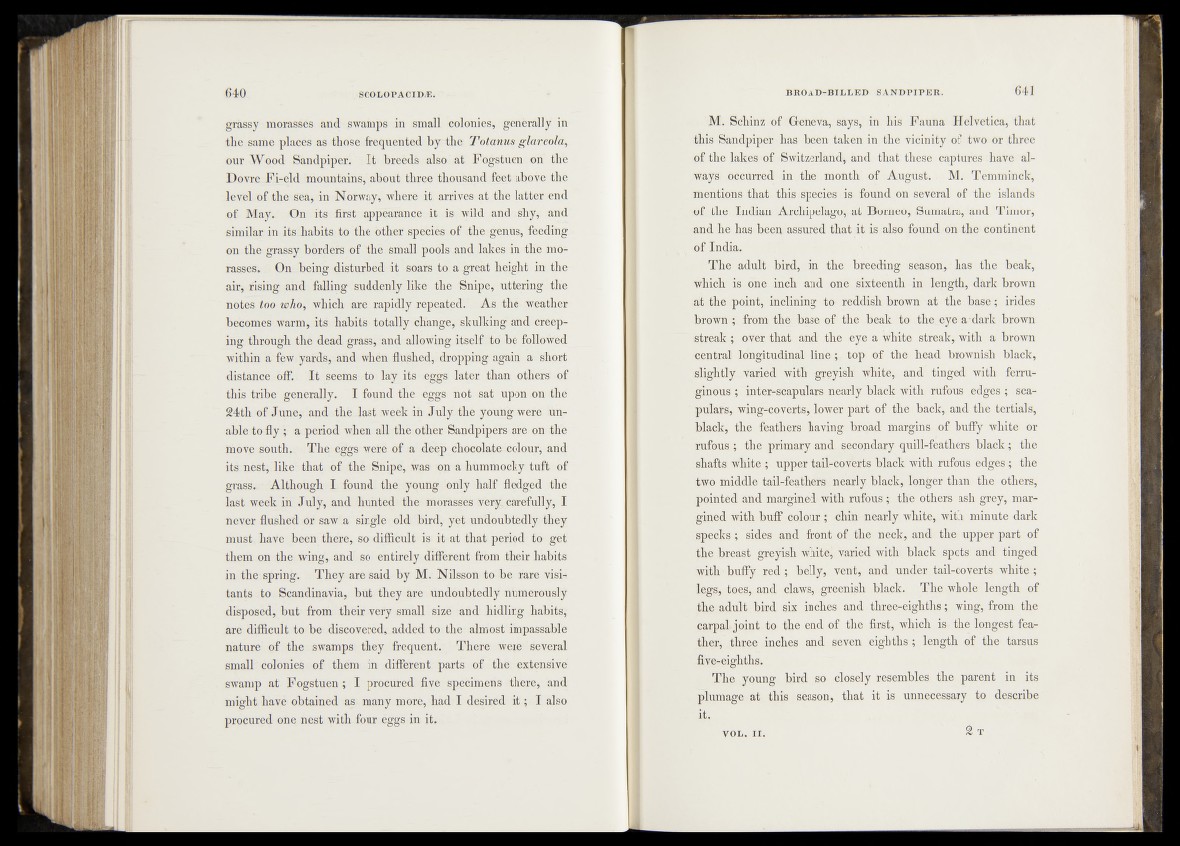
grassy morasses and swamps in small colonies, generally in
the same places as those frequented by the Totanus glareola,
our Wood Sandpiper. I t brééds also at Fogstuen on thé
Dovre Fi-eld mountains, about three thousand feet above the
level of the sea, in Norway, where it arrives at the latter end
of May* On its first appearance it is wild and . shy, and
similar in- itslhabits to the other species of the genus, feeding
on the grassy borders of the small pools and lakes in the morasses.
On being disturbed it soars to a great height in the
air, rising and falling suddenly like the Snipe, uttering the
notes too who, which are rapidly repeated.. As the weather
becomes warm, its habits totally change, skulking' and créep-
ing. through the dead grass, and allowing itself to be followed
within a few yards, and when flushed, dropping again a short
distance off,. I t seem&to lay its eggs later than others of
this tribe generally. I found the eggs not sat upon ,on the
24th of June, and thé last week in July the young were unable
to fly ; a period when all the other Sandpipers are on the
move south. The eggs were of a deep chocolate-colour, and
its nest, like that of thé Snipe, was on a hummocky tuft of
grass*. Although I found the young only half fledged the
last week in July, and hunted the morasses ’.very, carefully, I
never flushed Or saw a single old bird, .yet undoubtedly they
must, have been there, so difficult is it-at that period to get
them on the wing, and so entirely different from .their habits
in the spring. They are said by M. Nilsson to be rare visk
tants to Scandinavia, but they are undoubtedly numerously
disposed, but from their very small size and hidling habits,;
are difficult to be discovered, added to .the almost impassable
nature of the swamps they frequent. There were several
smalT colonies of them in different, parts of the extensive
swamp at Fogstuen; I procured five specimens there, and
might have obtained as many more, had I desired it ; ■ I also
procured one nest with four eggs in it.
M. Schinz of Geneva, says, in his Fauna Helvetica, that
this Sandpiper has been taken in the vicinity of two or three
of the lakes of Switzerland*, and that these captures have always
occurred in the month of August. M. Temminck,
mentions that this species is found on several of the islands
of the Indian Archipelago, at Borneo, Sumatra, and Timor,
and he has been assured that it is also found on the continent
of India.
The adult bird, in the breeding season, has the beak,
which is one inch and one sixteenth-in length, dark brown
at the point, inclining to reddish brown at the base; irides
brown ; from the base of the beak to the., eye a-dark brown
streak ; oyer that and the eye a white streak, with a brown
central longitudinal l i n e t o p of the head brownish black,
slightly, varied with greyish white, and tinged with ferruginous
; inter-scapulars nearly black with rufous edges ; scapulars,
wing-coverts, lower part of the back, and the tertials,
black, the feathers having broad margins of buffy white or
rufous ; the primary and secondary quill-feathers black; the
shafts white ; upper tail-coverts black with rufous edges; the
two middle tail-feathers nearly black, longer than the others,
pointed and margined with rufous; the others ash grey, margined
with buff colour ; chin nearly white, with minute dark
specks; sides and front of the neck, and the upper part of
the breast greyish white, varied with black spots and tinged
with1 buffy red; belly, vent, and under tail-coverts white;
legs, toes, and claws, greenish black. The whole length of
the adult bird six inches and three-eighths; wing, from the
carpal.joint to the end of the first, which is the longest feather,
three inches and seven eighths ; length of the tarsus
five-eighths.
The young bird so closely resembles the parent in its
plumage at this season, that it is unnecessary to describe
it.
VOL. I I . 2 T